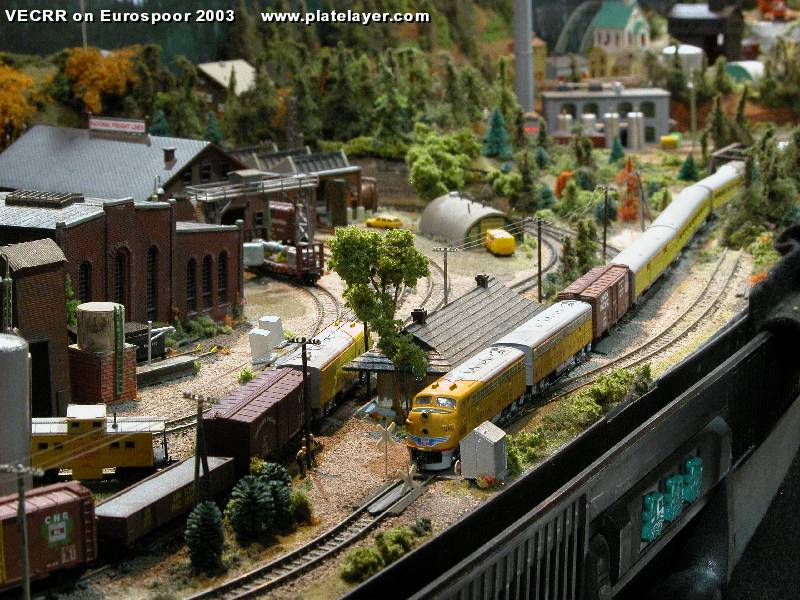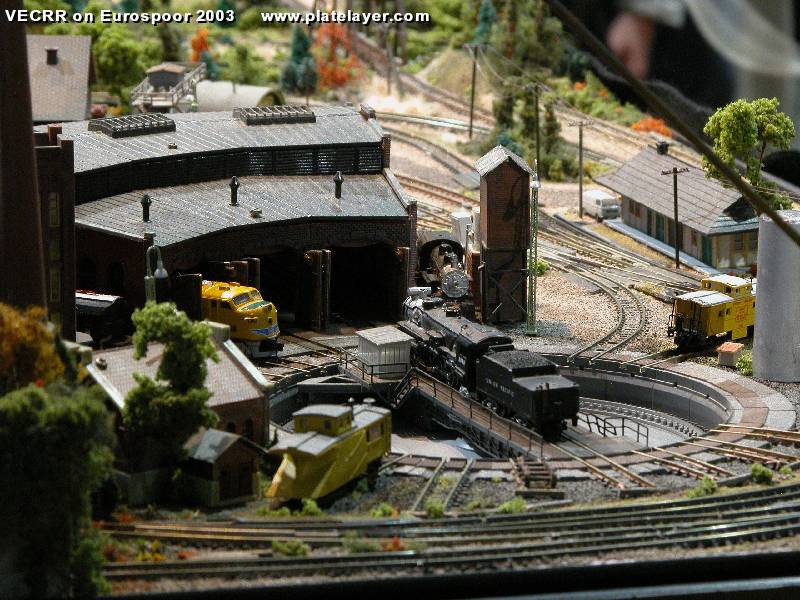The Val Ease Central Railroad ©
Taking Z Scale to the Public Around the World
(Text and photos © Copyright Jeffrey MacHan, photos by Svein-Martin Holt)
Last Spike: Confessions of a Railroad Modeller?
I know what you're thinking...a railroad or railway modeller is someone who tries to reproduce in miniature some aspect of a real-life railroad. We're all familiar with fellow Z-scalers who have chosen to model the Tehachapi Pass or the Gotthard Line. Well I submit to you that the term also applies to someone who has reproduced in miniature a fictitious or freelanced railroad. There are numerous examples such as John Allen's famous "Gorre & Daphetid", Lyn Wescott's "Sunset Railway & Navigation Co.", Tony Koester's "Allegheny Midland" just to name three well-known lines. These modellers created freelanced railroads just as real to many of their admirers as the Union Pacific RR or the DB. I'm not saying that the VEC is in the same class as the aforementioned railroads, but still, where does this leave "imagineered" railroads like the "Val Ease Central"? Can a "Chief Imagineer" be considered to be a railroad modeller? I believe that I can make the case.
I admit that there are still differences between "real", "freelance" and "imagineered" when it comes to crafting a miniature railroad. Freelancers often invest a great deal of effort scratch-building prototypically correct structures. Their layouts often have much in common with well-known "real" railroads. But what of the VEC? About the only thing it has in common with a real railroad is the spelling of "Union Pacific" on the rolling stock! Other than that, the rest is pretty much an impressionistic portrayal of a North American railroad. I didn't use any photos or measured drawings to craft my miniature world. That's why I call myself the Chief Imagineer and only one 'rule' applied to the VEC..."Don't look for perfection, perfect the look!"
Motto as vision statement
My motto is made up of two parts, A: the ATTITUDE part ("Don't look for perfection") and B: the ACTION part ("Perfect the look").
Part A (attitude) serves as a reminder to keep my general hobby goals
in sight.
Part B (action) sums up my modelling approach in support of part A.
My #1 hobby goal is to have FUN which means that I gave myself permission to Play. My SECONDARY hobby goals were chosen as the means to achieving goal #1:
- chose a scale with intrinsic "play" value = high "cuteness" and
"thrill of the hunt" factors,
- use "off-the-shelf" components whenever possible,
- employ very basic construction techniques,
- give free rein to my imagination and ignore "conventional" model
railroading thinking,
- build a miniature railroad in a suitcase and hope that it works!
- share the results with the world.
Almost immediately after having established these goals I began to do things quite differently compared to my previous layout-building experiences. My normal approach would have been to start playing with track plans and motive power rosters based on a favourite prototype line. Not this time...for three months before I began to envisage the initial track plan for Val Ease Central (the first suitcase), I played with concepts in my mind: era, setting, historical background and those imaginary inhabitants who would soon take up residence inside a 20" x 30" hard-side suitcase.
The result of this armchair "imagineering" was that my railroad came to life long before any track was laid. I also came to accept both the advantages and the limitations of working with Z. It was great fun inserting a believable (to me at least) model railroad into a suitcase. Because I was concerned with the "look" of the railroad, I soon became comfortable with the "imperfections" of the Z material I was working with. It was just as much fun searching for reasonable solutions to minimize the compromises that came with oversize rails, coarse details on locomotives and rolling stock, varying scale of "Z" structures from manufacturers, ugly Big Black Boxes on the Märklin turnouts, bizarre couplers, European tie spacing on an American railroad and so on.
Building the VEC became an ongoing opportunity to emphasize the scenic elements and to de-emphasize the deficiencies of the commercial z-scale components used on the layout. Once the trains ran reliably over the VECRR trackage, perfecting the "Look" became my priority.

It's the little things that make an image believable such as the scale telegraph wires and the speeder shed. Notice how the smaller-than-scale resin church by Märklin (shortened by the author) is used in the background for forced perspective. Photo courtesy of Svein-Martin Holt.
So just how do I go about "perfecting" the look?
Simply put, I try to observe my layout from varying distances and from unusual angles. I look at the VEC as if I were viewing an architectural miniature. I can "feel" when there is something out of place either by it being too strong or too weak thereby compromising the balance and harmony of the 3-D image. The "fix" can mean adding, removing or changing the shape of the physical elements (composition) in the scene and modifying colour and texture (detail). Not only do I try to insure that things appear to belong but also that nothing appears to be missing.
The first and probably most important element in creating an attractive visual environment is the backdrop. Interestingly enough, the backdrop is usually the last addition, if ever, to most layouts. Fortunately, I took the wise advice of Master Model Railroader, Doug Hole, and painted a twenty-inch high backdrop for the VEC. Because the backdrop was painted to complement and enhance the existing foreground elements the visual impact was probably more effective than if it had been painted in the early stages of building the VEC. The lucky few who have been present when I install the backdrop and turn on the halogen spot lighting can attest to the instant transformation.
Beyond attention to detail
I believe that attention to detail is important but only in relation to its contribution to the overall effect.
You may be familiar with the three-foot rule in model railroading...work on a scene until it looks good from three feet away. When working on the VEC, I apply a series of "foot rules", the 10-foot rule (far enough away to view the entire layout), the 2-foot rule (the distance at which a single section of the VEC fills my field of view) and the 8-inch rule (the distance that any viewer can approach any particular scene on the layout and also the approximate distance that the eye will naturally focus). Visitors to the VEC like to get to within inches of the layout, their noses approaching the telegraph wires. In fact, at NMRA competitions, the judges were often peering at scenes on the layout from a foot away or less.

Some details you see: wheelsets rusting on a turntable lead, a snow plow parked until that big snow fall...and some you don't: switch motors, floating buildings, bare metal rails. Photo courtesy of Svein-Martin Holt.
Another important factor is to respect the same depth of detail in order to maintain the illusion in the viewer's mind. By placing an ultra-detailed object and a less-detailed object in the same visual frame of focus, the global illusion will be destroyed. The viewer senses that there is something amiss without knowing exactly what. This point was driven home to me by Reynard Wellman of Micron Art. When I was building Centre Val Ease, I had a spot reserved for a factory building. I was considered the MA etched-brass foundry for the layout. When I approached Reynard at a National Train Show and mentioned that I was thinking of adding his foundry to the VEC, rather than asking for my credit card he pointed out that the MA structure might be too detailed for the layout. Despite my initial surprise at a vendor turning down a sale, I did see his point. My hunt continued and I eventually found a LifeLike chemical plant that I transformed for CVE. The broad details of the plastic structure and its made-to-measure footprint fit in perfectly with the overall scene. [Sounds like a future article!]
Gestalt, anyone?
In the course of a thought-provoking conversation at the Toronto Christmas Train Show in 2001, visiting Z-scaler Jeff Rothfus observed that, viewed from a certain distance, the VEC shows a visual balance and harmony that produces a Gestalt* effect. He gave the example that individual structures like the VEE Main Station look questionable when taken out of context but when viewed from a few feet distance, the station contributes to the overall success of the scene.
*[noun] configuration or pattern of elements so unified as a whole that it cannot be described as a sum of its parts.
I have one last argument to present in support of my case. To my knowledge, the VEC has something uniquely "Valeasian"..."Valeasians"! There are more than one hundred identifiable inhabitants of Val Ease County some of whose stories you have read in the pages of Ztrack. These colourful characters do things, have jobs, secrets, embarrassing moments even!. Through them you and I can experience the VEC at a level that goes far beyond any "freelance" railroad that I'm familiar with. I'm willing to wager that you can probably name the president of the VECRR [Right! Miles O'Track], the mayor of Val Ease East [gotcha there! Hizzoner] or the intrepid roving reporter [that one was easy...Mike Ruffone].
Wait a minute! When I stop to think about the case I have presented today, I am tempted to withdraw my claim to be a "railroad modeller". By all accounts the VEC has been a success both technically and artistically. If Jeff Rothfus is correct, the whole of the VEC is greater than the sum of its parts which could also be rephrased to say that the VEC is "larger than life". Maybe it really is in a category all by itself. Dear readers, after careful consideration I am changing my declaration. I'm not a "railroad modeller", I'm a "railroad imagineer" and proud of it!
"Don't Look for Perfection, Perfect the Look!"